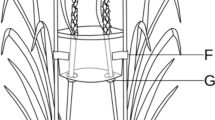Summary
Gregarious nymphs of the desert locust,Schistocerca gregaria (Forsk.) (Orthoptera: Acrididae) were more attracted to volatiles from mechanically damaged food plants used for rearing than to either the undamaged or damaged food plants not used as diet in Y-tube olfactometer assays. Comparative analysis of the volatile emissions from plants used for rearing and food plants not used for rearing,e.g. Sorghum bicolor, Pennisetum clandestinum, Schouwia thebaica, wheat (Triticum sp., var. ‘Nyangumi’),Zygophyllum simplex, Heliotropium undulatum andTribulus terrestris was carried out by GC, GC-EAD and GC-MS. Significant quantitative and qualitative differences were found in the volatile emissions and olfactory responses of nymphs in GC-EAD assays. Up to 33 compounds were identified in volatiles of the plants of which 9 evoked EAGs. EAG-active components included common green leaf compounds (E)-2-pentenal, (E)-2-hexenal, 4-methyl-3-pentenal, (E)-3-hexenyl acetate, (Z)-3-hexenyl acetate, (Z)-2-hexenyl acetate, (Z)-3-hexen-1-ol and (Z)-2-hexen-1-ol. (Z)-3-Hexenyl butyrate and (Z)-3-hexenyl isovalerate were detected in stimulatory amounts only in the volatiles ofS. thebaica. (E, Z)-2,6-Nonadienal was detected as a component in the volatiles ofT. terrestris and was highly stimulatory. In EAG assays with seven common green leaf volatiles, (Z)-3-hexenyl acetate was most stimulatory while hexanal was the least. No significant differences were recorded between antennal responses of males and females to the tested compounds. These results are discussed with regard to current hypotheses on host plant recognition through detection of their airborne volatiles and the learning behaviour by nymphs ofS. gregaria.
Similar content being viewed by others
References
Bernays EA, Wrubel RP (1986) Learning by grasshoppers: Association of colour/light intensity with food. Physiol Entomol 10:359–369
Blaakmeer A, Geervliet JBF, van Loon JJA, Posthumus MA, van Beek TA, de Groot AE (1994) Comparative headspace analysis of cabbage plants damaged by two species ofPieris caterpillars: consequences for in-flight host location byCotesia parasitoids. Entomol exp appl 73:175–182
Dickens JC, Smith JW, Light DM (1993) Green leaf volatiles enhance sex attractant pheromone of the tobacco budworm,Heliothis virescens (Lepidoptera: Noctuidae). Chemoecology 4:175–177
Fein BL, Reissig WH, Roelofs WL (1982) Identification of apple volatiles attractive to apple maggot,Rhagoletis pomonella. J Chem Ecol 8:1473–1487
Haskell PT, Paskin MWJ, Moorhouse JE (1962) Laboratory observation on factors affecting the movement of hoppers of the desert locust. J Insect Physiol 8:53–78
Hopkins TL, Young H (1990) Attraction of the grasshopper,Melanopus sanguinipes to host plant odours and volatile components. Entomol exp appl 56:249–258
Kennedy JS, Moorhouse JE (1969) Laboratory observations on locust responses to windborne grass odour. Entomol exp appl 12:487–503
Lee JC, Bernays EA, Wrubel RP (1987) Does learning play a role in host location and selection by grasshoppers? Pp 125–127in Labeyrie V, Fabres G, Lachaise D (eds) Insects and Plants — Proceedings of the 6th Int Symposium on Insect-Plant Relationships (Pau 1986). NL-Dordrecht: W. Junk
Light DM, Frath RA, Buttery RG, Zalom RG, Rice RE, Dickens JC, Jang EB (1993) Host-plant green-leaf volatiles synergize the synthetic sex pheromones of corn earworm and codling moth (Lepidoptera). Chemoecology 4:145–152
Mattiaci L, Dicke M. Posthumus MA (1994) Induction of parasitoid attracting synomones in Brussels sprouts plants by feeding ofPieris brassicae larvae: role of mechanical damage and herbivore elicitor. J Chem Ecol 20:2229–2247
Moorhouse JE (1971) Experimental analysis of the locomotor behaviour ofSchistocerca gregaria induced by odour. J Insect Physiol 17:913–920
Obeng-Ofori D, Njagi PGN, Torto B, Hassanali A, Amiani H (1993) Sex differentiation studies relating to releaser aggregation pheromones of the desert locust,Schistocerca gregaria. Entomol exp appl 73:85–91
Papaj DR, Prokopy RJ (1986) Phytochemical basis of learning inRhagoletis pomonella and other herbivorous insects. J Chem Ecol 12:1125–1143
Rice MJ (1989) The sensory physiology of pest fruit flies: Conspectus and prospectus. Pp 250–272in Robinson AS, Hooper GHS (eds) Fruit Flies, Their Biology, Natural Enemies and Control. World Crop Pests, Vol 3A. NL-Amsterdam: Elsevier
Schoonhoven LM (1968) Chemosensory basis of hostplant selection. Annu Rev Entomol 13:115–136
Thiery D, Visser JH (1987) Misleading the Colorado potato beetle with an odor blend. J Chem Ecol 13:1139–1146
Torto B, Obeng-Ofori D, Njagi PGN, Hassanali A, Amiani HC (1994) Aggregation pheromone system of the adult gregarious desert locust,Schistocerca gregaria (Forskal) (Orthoptera: Acrididae). J Chem Ecol 20:1749–1762
Turlings TCJ, Tumlinson JH, Eller FJ, Lewis WJ (1991) Larval-damaged plants: Source of volatile synomone that guide the parasitoidCostesia marginiventris to the micro-habitat of its hosts. Entomol exp appl 58:75–82
Van der Pers JNC (1981) Comparison of electroantennogram response spectra to plant volatiles in sevenYponomeuta and in the tortricidAdoxophyes orana. Entomol exp appl 30:181–192
Visser JH (1986) Host odour perception in phytophagous insects. Annu Rev Entomol 31:121–144
Visser JH, Ave DA (1978) General leaf volatiles in the olfactory orientation of the Colorado beetle,Leptinotarsa decemlineata. Entomol exp appl 24:738–749
Visser JH, Van Straten S, Maarse H (1979) Isolation and identification of volatiles in the foliage of potato,Solanum tuberosum, a host plant of the Colorado beetle,Leptinotarsa decemlineata. J Chem Ecol 5:13–25
Whitman DM, Eller FJ (1990) Parasitic wasps orient to green leaf volatiles. Chemoecology 1:69–75
Author information
Authors and Affiliations
Rights and permissions
About this article
Cite this article
Njagi, P.G.N., Torto, B. Responses of nymphs of desert locust,Schistocerca gregaria to volatiles of plants used as rearing diet. Chemoecology 7, 172–178 (1996). https://doi.org/10.1007/BF01266309
Issue Date:
DOI: https://doi.org/10.1007/BF01266309




